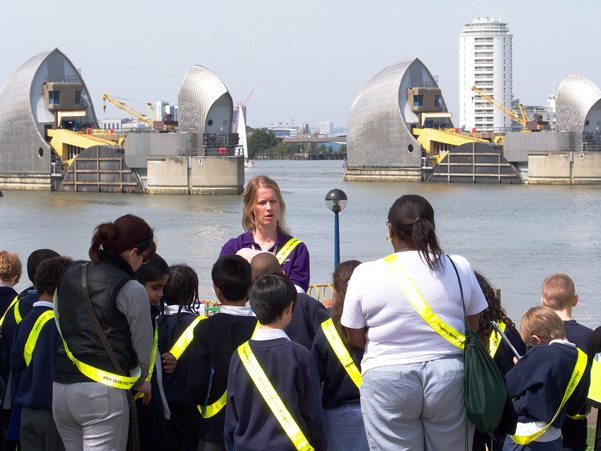By Violet Law
LONDON - They are the modern-day knights in shining armor, guarding London from their outposts in the River Thames. Each rises 66 feet – nearly seven stories above the water – and sports a stainless steel skin over its 4,000-ton hulk. They stand shoulder to shoulder across the width of the river, ready for action whenever roiling tides threaten to inundate the city.
They are London’s seven flood gates – collectively known as the Thames Barrier. They form London’s main defense against tidal surges that could swallow the city whole. They were designed in the 1960s and 1970s to stand guard forever. But experts are concerned now that rising sea levels resulting from Global Warming could make them obsolete.
At the moment, scientists and government officials are groping for a strategy and the right gear to cope with expected higher sea levels. “In a sense, we’re buying time,” said Edmund Penning-Rowsell, who heads the Flood Hazard Research Centre at Middlesex University in London in an interview.
When the flood gates were completed in 1983, they were regarded by some as the Eighth Wonder of the World. They were an engineering feat that featured 1,500 ton steel gates that opened and closed with a state-of-the-art hydraulic system.
At low tide, the gates swing open and out of the way of shipping traffic. They stand open most of the year. The barrier rises six miles from central London and not far from the historic naval town Greenwich, whose prime meridian gives the world navigational bearings and is the international marker for calculating the time of day. The flood gates are 20 miles from the mouth of the Thames as it flows into the North Sea.
The best thinking now is that it may take until 2070 for Climate Change to push sea levels to extremely dangerous heights. In the lives of most people that sounds like forever. And there is little urgency for government spending on the scale needed to replace the flood gates. The flood gates cost $536 million in pounds sterling to build or nearly $3 billion in today’s dollars. Instead of moving to replace the gates now, said a recent report by the Environment Agency of England and Wales, the focus has been on maintaining the flood gates. The report was titled the Thames Estuary 2100.
Mr. Penning-Rowsell and other experts are pushing the government to get started on the project now. But flood control in England is a slow-moving business. It was a flood in 1953 that inspired the building of today’s flood gates. Thirty years later they went into operation. A similar time-table would give London plenty of lead time in the race with nature. But it is a lead that could be lost to complacency, Mr. Penning-Rowsell and other experts say.
Already the flood gates are under stress. They were designed to close 15 to 20 times a year. In February alone they went into action a dozen times to block high water caused by ice melt runoff up river in the interior of England. The more frequent use, some experts said, is more a reflection of stepped-up efforts to prevent small-scale flooding, than an indication of the impact of Climate Change on sea levels.
Even people who have experienced the wrath of an angry Thames River first hand see little to worry about. Kathleen Smith lived through the flood of 1953.
She was 10 years old then. In an interview, she recalled rushing to an upstairs bedroom as the flood waters rose to just under her chin. She was in one of the least affected parts of London. In some places, she said, cars drifted away like matchboxes. More than 300 people drowned.
The other day, Ms. Smith went for a walk along the Thames. She followed a promenade with breath-taking views of the broad, Gray River and beautiful lawns sloping off to the sides. Nearby, young voices chirped in a playground with brightly painted swings and slides.
Signs along the promenade warn of treacherous high tides. But on most days it takes a powerful imagination to sense the danger. “Until things actually happen,” Ms. Smith said, “you don’t think about it.” #

